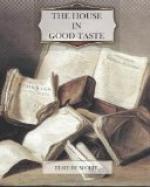A piano may be a princely thing, properly built and decorated. The old spinets and harpsichords, with their charming inlaid cases, were beautiful, but they gave forth only tinkly sounds. Now we have a magnificent mechanism, but the case which encloses it is too often hideous.
There is an old double-banked harpsichord of the early Eighteenth Century in the Morgan collection at the Metropolitan Museum that would be a fine form for a piano, if it would hold the “works.” It is long and narrow, fitting against the wall so that it really takes up very little room. The case is painted a soft dark gray and outlined in darker gray, and the panels and the long top are in soft colors. The legs are carved and pointed in polychrome. This harpsichord was made when the beauty of an object was of as real importance as the mechanical perfection.
Occasionally one sees a modern piano that has been decorated by an artist. Sir Edward Burne-Jones, Sir Alma Tadema, and many of the other English artists of our generation have made beautiful pianos. Sir Robert Lorimer recently designed a piano that was decorated, inside and out, by Mrs. Traquair. From time to time a great artist interests himself in designing and decorating a piano, but the rank and file, when they decide to build an extraordinary piano, achieve lumpy masses of wood covered with impossible nymphs and too-realistic flowers, pianos suggestive of thin and sentimental tunes, but never of music.
When you are furnishing your music-room or drawing-room, be careful always of your colors. Remember that not only must the room be beautiful in its broad spaces and long lines and soft colors, but it must be a background for the gala gowns of women. I once saw a music-room that was deliberately planned as a background to the gay colors of women’s gowns and the heavy black masses of men’s evening clothes, a soft shimmering green and cream room that was incomplete and cold when empty of the color of costume. Such a room must have an architectural flavor. The keynote must be elegant simplicity and aristocratic reserve. Walls broken into panels, and panels in turn broken by lighting-fixtures, a polished floor, a well-considered ceiling, any number of chairs, and the room is furnished. This room, indeed, may evolve into a salon.
XI
THE LIVING-ROOM
The living-room! Shut your eyes a minute and think what that means: A room to live in, suited to all human needs; to be sick or sorry or glad in, as the day’s happenings may be; where one may come back from far-reaching ways, for “East or West, Hame’s best.”
Listen a minute while I tell you how I see such a room: Big and restful, making for comfort first and always; a little shabby here and there, perhaps, but all the more satisfactory for that—like an old shoe that goes on easily. Lots of light by night, and not too much drapery to shut out the sunlight by day. Big, welcoming chairs, rather sprawly, and long sofas. A big fire blazing on the open hearth. Perhaps, if we are very lucky we may have some old logs from long since foundered ships, that will flame blue and rose and green. He must indeed be of a poor spirit who cannot call all sorts of visions from such a flame!




